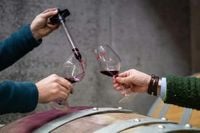Concerns about per- and polyfluoroalkyl substances (PFAS) have recently emerged in the wine industry, raising eyebrows even among pesticide-free winegrowers. Jântsje Hoogkamp, co-owner of Nij Abdij de Heidepleats in Sint Nicolaasga, expressed her worries about whether these chemicals are present in their products. "Sit it dêr no ek al yn?" she questioned, reflecting the anxiety shared by many in the sector.
On April 30, 2025, a report by the Pesticide Action Network Europe stirred the pot, claiming that there are "alarmingly high concentrations of PFAS" in European wine. This revelation has sparked a heated debate about the safety of wine consumption, echoing previous concerns over various food products that have been scrutinized for pesticide residues.
Ronald de Groot, a prominent figure in the wine industry and editor at the magazine Perswijn, offered a counterpoint to the report's alarming tone. He highlighted that to reach the European limit for trifluoroacetic acid (TFA), one would need to consume an astounding 200 glasses of wine per day. De Groot's comment underscores a key issue in the discussion: the practical implications of the findings.
In light of the report, many winegrowers are frustrated by the negative spotlight cast upon their industry. Ilja Gort, another winegrower, voiced his discontent with the notion that wine production is being scapegoated for broader environmental issues related to PFAS. "Ik ben erop tegen dat ze de wijnbouw als pispaal nemen," he asserted, emphasizing that many in the wine industry, particularly organic producers, are committed to sustainable practices.
The controversy surrounding PFAS is not new. These substances, often referred to as "forever chemicals," are used in various industrial applications and have been linked to environmental and health concerns. Critics argue that the wine industry should not bear the brunt of the blame for contamination that stems from larger industrial practices.
As discussions continue, some advocates caution against overreacting to the findings. The sentiment among many wine enthusiasts is to enjoy their wine without undue concern, provided they are not consuming excessive quantities. The idea of moderation resonates strongly, especially in a culture that has long celebrated wine as part of social gatherings and culinary experiences.
The report from the Pesticide Action Network Europe has ignited a broader conversation about food safety and environmental responsibility. While the presence of PFAS in wine poses legitimate questions, it also reflects a need for a nuanced understanding of the complexities involved in agricultural production and chemical use.
As the wine industry grapples with these challenges, it is essential for consumers to remain informed and engaged. The debate over PFAS in wine serves as a reminder of the interconnectedness of food production, environmental health, and consumer choices. Winegrowers like Hoogkamp and Gort are at the forefront of this discussion, advocating for responsible practices while navigating the challenges posed by external pressures.
Ultimately, the future of wine production in the face of PFAS concerns will depend on collaboration among growers, regulators, and consumers. As the industry seeks to balance safety and tradition, it will be crucial to foster a dialogue that prioritizes both public health and the livelihoods of those who produce wine.
For now, wine lovers can take solace in the fact that moderation remains a key principle. As long as one does not indulge excessively, there seems to be little cause for alarm regarding PFAS in wine. The industry continues to evolve, and with it, the practices that ensure the quality and safety of the wines we enjoy.

